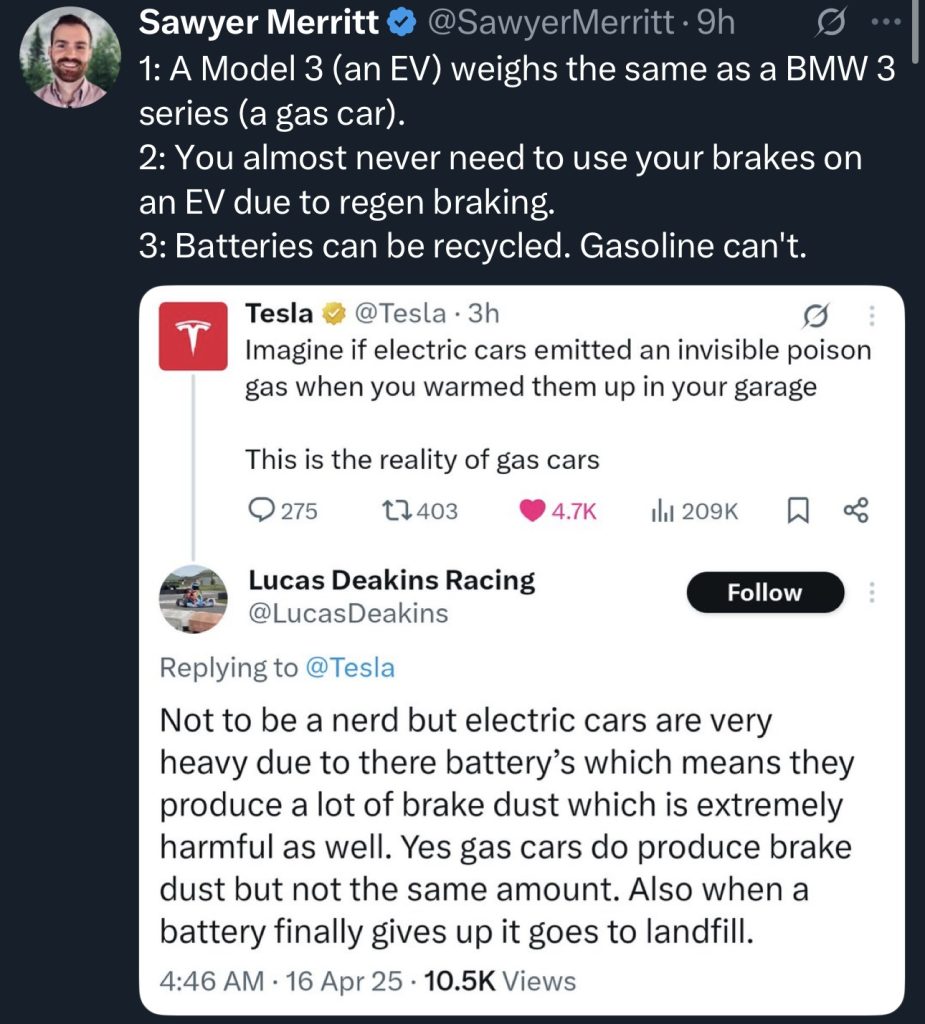EVs vs. Gas Cars: Debunking Myths and Understanding the Benefits of Going Electric
As the world races toward cleaner and smarter mobility, the electric vehicle (EV) vs. gas car debate continues to fire up social media and policy discussions. A recent post on X (formerly Twitter) by Tesla and auto analyst Sawyer Merritt reignited this conversation by highlighting key advantages of EVs over traditional internal combustion engine (ICE) vehicles.

Let’s break down the facts , and clear up the misunderstandings.
1. Weight and Regenerative Braking: Efficiency in Motion
One claim often lobbed at EVs is that they are “too heavy.” While it’s true that electric vehicles carry large battery packs, it’s misleading to frame that as inherently worse. Merritt notes that a Tesla Model 3 , a mid-size electric sedan , weighs roughly the same as a BMW 3 Series, a common gas-powered counterpart.
More importantly, EVs use regenerative braking, which captures kinetic energy during deceleration and returns it to the battery. This not only extends driving range but significantly reduces wear on traditional brake components , meaning fewer brake replacements and less brake dust pollution over time. Gas cars lack this efficient system entirely.
2. Brake Dust: Not Just an EV Problem
In a critical reply, one user mentioned that EVs create more brake dust due to battery weight. However, this is misleading. While heavier cars can create more brake dust, the actual output in EVs is mitigated by regenerative braking, which takes on much of the deceleration load. A study by the California Air Resources Board (CARB) noted that regen braking can reduce particulate emissions from brake pads by over 90%.
In fact, many high-performance EVs barely use their physical brakes in city driving, unlike gas cars which rely on them constantly.
3. Emissions: Where EVs Win Big
A viral Tesla post asked users to “imagine if gas cars emitted invisible poison gas when you warmed them up in your garage.” That’s not imagination , it’s reality. Gasoline vehicles release carbon monoxide, nitrogen oxides, and unburned hydrocarbons, especially when idling or cold-starting. These pollutants are hazardous to both health and the environment.
EVs? Zero tailpipe emissions. No idling danger in enclosed spaces. And when powered by renewable electricity, their carbon footprint shrinks even further.
4. Recycling and End-of-Life Impact
EV critics often claim that lithium-ion batteries end up in landfills. But the battery recycling industry is growing rapidly. Companies like Redwood Materials and Li-Cycle are already recovering over 95% of metals like lithium, nickel, and cobalt from used EV batteries. Meanwhile, gasoline? It’s burned and gone forever , non-recyclable and polluting by design.
Also worth noting: when EV batteries no longer serve in cars, many are repurposed in stationary energy storage, giving them a second life before ever hitting a recycler.
5. Total Cost of Ownership: Long-Term Win
Upfront costs of EVs can be higher, but lower maintenance, fewer repairs, and cheaper “fuel” (electricity vs. gas) add up. Recent studies show that over a 5–10 year span, most EVs are cheaper to own and operate than comparable gas vehicles, even without government incentives.
The Verdict
Yes, electric vehicles have challenges , such as raw material sourcing, charging infrastructure, and manufacturing emissions. But in terms of air quality, running cost, maintenance, and long-term sustainability, EVs clearly outpace gas-powered cars.
The transition to cleaner mobility isn’t just about hype , it’s about facts, science, and rethinking how we move.